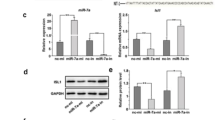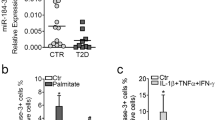Abstract
Aim
To examine the effect of lncRNA Kcnq1ot1 on pancreatic β cells in the development of diabetes.
Methods
The expression levels of Kcnq1ot1 were detected in the islets of diabetes mouse models and the serum of patients with type 2 diabetes by qRT-PCR. CCK8, Ki67 staining, immunohistochemical analyses, glucose-stimulated insulin secretion and intraperitoneal glucose tolerance test were performed to detect the effect of Kcnq1ot1 on β-cell proliferation and insulin secretion in vitro and in vivo. The relationship between Kcnq1ot1 and miR-15b-5p was predicted by bioinformatics prediction, which was confirmed by luciferase reporter assay.
Results
Kcnq1ot1 was more abundant in the pancreas. The expression of Kcnq1ot1 was decreased in the islets of db/db mice and diet-induced obese mice and in the serum of patients with type 2 diabetes. Silencing Kcnq1ot1 inhibited the β-cell proliferation concomitant with a reduction in the levels of Ccnd1 and Ccnd2. Insulin synthesis and secretion were impaired, along with the decreased expression of Ins1, Ins2, and insulin-related transcription factors. Moreover, Kcnq1ot1 knockdown in vivo reduced glucose tolerance and decreased insulin secretion, consistent with the reduction in the relative islet area and Ki67-positive β-cells detected by immunochemistry and immunofluorescence staining, respectively. Mechanistically, Kcnq1ot1 directly targeted miR-15b-5p which regulated β-cell proliferation and insulin secretion through Ccnd1 and Ccnd2. Notably, the suppression of miR-15b-5p attenuated the inhibition of Min6 proliferation and insulin production induced by Kcnq1ot1 knockdown.
Conclusion
Kcnq1ot1 regulated β-cell proliferation and insulin secretion via the miR-15b-5p/Ccnd1 and Ccnd2 axis, which is worthy of further investigation considering its potential in diabetes treatment.








Similar content being viewed by others
References
Eizirik DL, Pasquali L, Cnop M (2020) Pancreatic β-cells in type 1 and type 2 diabetes mellitus: different pathways to failure. Nat Rev Endocrinol 16(7):349–362. https://doi.org/10.1038/s41574-020-0355-7
Hudish LI, Reusch JE, Sussel L (2019) β Cell dysfunction during progression of metabolic syndrome to type 2 diabetes. J Clin Investig 129(10):4001–4008. https://doi.org/10.1172/jci129188
López-Noriega L, Rutter GA (2020) Long non-coding RNAs as key modulators of pancreatic β-Cell mass and function. Front Endocrinol 11:610213. https://doi.org/10.3389/fendo.2020.610213
Guay C, Jacovetti C, Bayazit MB, Brozzi F, Rodriguez-Trejo A, Wu K et al (2020) Roles of noncoding RNAs in islet biology. Compr Physiol 10(3):893–932. https://doi.org/10.1002/cphy.c190032
Filios SR, Shalev A (2015) β-Cell MicroRNAs: small but powerful. Diabetes 64(11):3631–3644. https://doi.org/10.2337/db15-0831
Eddy SR (2001) Non-coding RNA genes and the modern RNA world. Nat Rev Genet 2(12):919–929. https://doi.org/10.1038/35103511
Clark MB, Mattick JS (2011) Long noncoding RNAs in cell biology. Semin Cell Dev Biol 22(4):366–376. https://doi.org/10.1016/j.semcdb.2011.01.001
Liu B, Xiang W, Liu J, Tang J, Wang J, Liu B et al (2021) The regulatory role of antisense lncRNAs in cancer. Cancer Cell Int 21(1):459. https://doi.org/10.1186/s12935-021-02168-4
Zhang W, Zheng J, Hu X, Chen L (2019) Dysregulated expression of long noncoding RNAs serves as diagnostic biomarkers of type 2 diabetes mellitus. Endocrine 65(3):494–503. https://doi.org/10.1007/s12020-019-02015-7
Morán I, Akerman I, van de Bunt M, Xie R, Benazra M, Nammo T et al (2012) Human β cell transcriptome analysis uncovers lncRNAs that are tissue-specific, dynamically regulated, and abnormally expressed in type 2 diabetes. Cell Metab 16(4):435–448. https://doi.org/10.1016/j.cmet.2012.08.010
Yin DD, Zhang EB, You LH, Wang N, Wang LT, Jin FY et al (2015) Downregulation of lncRNA TUG1 affects apoptosis and insulin secretion in mouse pancreatic β cells. Cell Physiol Biochem Int J Exp Cell Phys Biochem Pharmacol 35(5):1892–1904. https://doi.org/10.1159/000373999
Zhu Y, Li Y, Dai C, Sun L, You L, De W et al (2018) Inhibition of Lincpint expression affects insulin secretion and apoptosis in mouse pancreatic β cells. Int J Biochem Cell Biol 104:171–179. https://doi.org/10.1016/j.biocel.2018.09.004
Kanduri C (2011) Kcnq1ot1: a chromatin regulatory RNA. Semin Cell Dev Biol 22(4):343–350. https://doi.org/10.1016/j.semcdb.2011.02.020
Chen QH, Li B, Liu DG, Zhang B, Yang X, Tu YL (2020) LncRNA KCNQ1OT1 sponges miR-15a to promote immune evasion and malignant progression of prostate cancer via up-regulating PD-L1. Cancer Cell Int 20:394. https://doi.org/10.1186/s12935-020-01481-8
Shao J, Pan X, Yin X, Fan G, Tan C, Yao Y et al (2019) KCNQ1OT1 affects the progression of diabetic retinopathy by regulating miR-1470 and epidermal growth factor receptor. J Cell Physiol 234(10):17269–17279. https://doi.org/10.1002/jcp.28344
Guay C, Regazzi R (2015) MicroRNAs and the functional β cell mass: for better or worse. Diabetes Metab 41(5):369–377. https://doi.org/10.1016/j.diabet.2015.03.006
Li WD, Xia JR, Lian YS (2019) MiR-15b can target insulin receptor to regulate hepatic insulin signaling in mice. Animal Cells Syst 23(2):82–89. https://doi.org/10.1080/19768354.2019.1583125
Thomson DW, Dinger ME (2016) Endogenous microRNA sponges: evidence and controversy. Nat Rev Genet 17(5):272–283. https://doi.org/10.1038/nrg.2016.20
Jiang X, Cao Y, Li F, Su Y, Li Y, Peng Y et al (2014) Targeting β-catenin signaling for therapeutic intervention in MEN1-deficient pancreatic neuroendocrine tumours. Nat Commun 5:5809. https://doi.org/10.1038/ncomms6809
Su Y, Jiang X, Li Y, Li F, Cheng Y, Peng Y et al (2016) Maternal low protein isocaloric diet suppresses pancreatic β-cell proliferation in mouse offspring via miR-15b. Endocrinology 157(12):4782–4793. https://doi.org/10.1210/en.2016-1167
Zeng W, Tang J, Li H, Xu H, Lu H, Peng H et al (2018) Caveolin-1 deficiency protects pancreatic β cells against palmitate-induced dysfunction and apoptosis. Cell Sig 47:65–78. https://doi.org/10.1016/j.cellsig.2018.03.013
Du X, Shi J (2021) UBA2 promotes the progression of renal cell carcinoma by suppressing the p53 signaling. Ir J Med Sci. https://doi.org/10.1007/s11845-021-02763-4
You L, Wang N, Yin D, Wang L, Jin F, Zhu Y et al (2016) Downregulation of long noncoding RNA Meg3 affects insulin synthesis and secretion in mouse pancreatic beta cells. J Cell Physiol 231(4):852–862. https://doi.org/10.1002/jcp.25175
Chen LL (2016) Linking long noncoding RNA localization and function. Trends Biochem Sci 41(9):761–772. https://doi.org/10.1016/j.tibs.2016.07.003
Li M, Shao F, Qian Q, Yu W, Zhang Z, Chen B et al (2021) A putative long noncoding RNA-encoded micropeptide maintains cellular homeostasis in pancreatic β cells. Mol Ther Nucl Acids 26:307–320. https://doi.org/10.1016/j.omtn.2021.06.027
Xiong L, Gong Y, Wu L, Li J, He W, Zhu X et al (2020) LncRNA-Malat1 is involved in lipotoxicity-induced ß-cell dysfunction and the therapeutic effect of exendin-4 via Ptbp1. Endocrinology. https://doi.org/10.1210/endocr/bqaa065
Zhao X, Rong C, Pan F, Xiang L, Wang X, Hu Y (2018) Expression characteristics of long noncoding RNA uc.322 and its effects on pancreatic islet function. J Cell Biochem 119(11):9239–9248. https://doi.org/10.1002/jcb.27191
Jin F, Wang N, Zhu Y, You L, Wang L, De W et al (2017) Downregulation of long noncoding RNA Gas5 Affects Cell Cycle and Insulin Secretion in Mouse Pancreatic β Cells. Cell Physiol Biochem Int J Exp Cell Physiol Biochem Pharmacol 43(5):2062–2073. https://doi.org/10.1159/000484191
Cnop M, Welsh N, Jonas JC, Jörns A, Lenzen S, Eizirik DL (2015) Mechanisms of pancreatic beta-cell death in type 1 and type 2 diabetes: many differences, few similarities. Diabetes 54(Suppl 2):S97-107. https://doi.org/10.2337/diabetes.54.suppl_2.s97
Chadt A, Yeo GS, Al-Hasani H (2012) Nutrition-/diet-induced changes in gene expression in pancreatic β-cells. Diabetes Obes Metab 14(Suppl 3):57–67. https://doi.org/10.1111/j.1463-1326.2012.01640.x
Cnop M, Abdulkarim B, Bottu G, Cunha DA, Igoillo-Esteve M, Masini M et al (2014) RNA sequencing identifies dysregulation of the human pancreatic islet transcriptome by the saturated fatty acid palmitate. Diabetes 63(6):1978–1993. https://doi.org/10.2337/db13-1383
Pandey RR, Mondal T, Mohammad F, Enroth S, Redrup L, Komorowski J et al (2008) Kcnq1ot1 antisense noncoding RNA mediates lineage-specific transcriptional silencing through chromatin-level regulation. Mol Cell 32(2):232–246. https://doi.org/10.1016/j.molcel.2008.08.022
Bian Y, Gao G, Zhang Q, Qian H, Yu L, Yao N et al (2019) KCNQ1OT1/miR-217/ZEB1 feedback loop facilitates cell migration and epithelial-mesenchymal transition in colorectal cancer. Cancer Biol Ther 20(6):886–896. https://doi.org/10.1080/15384047.2019.1579959
Feng W, Wang C, Liang C, Yang H, Chen D, Yu X et al (2018) The dysregulated expression of KCNQ1OT1 and its interaction with downstream factors miR-145/CCNE2 in breast cancer cells. Cell Physiol Biochem Int J Exp Cell Physiol Biochem Pharmacol 49(2):432–446. https://doi.org/10.1159/000492978
Zhao SF, Ye YX, Xu JD, He Y, Zhang DW, Xia ZY et al (2021) Long non-coding RNA KCNQ1OT1 increases the expression of PDCD4 by targeting miR-181a-5p, contributing to cardiomyocyte apoptosis in diabetic cardiomyopathy. Acta Diabetol 58(9):1251–1267. https://doi.org/10.1007/s00592-021-01713-x
Kushner JA, Ciemerych MA, Sicinska E, Wartschow LM, Teta M, Long SY et al (2005) Cyclins D2 and D1 are essential for postnatal pancreatic beta-cell growth. Mol Cell Biol 25(9):3752–3762. https://doi.org/10.1128/mcb.25.9.3752-3762.2005
Pan FC, Wright C (2011) Pancreas organogenesis: from bud to plexus to gland. Dev Dyn An Off Publ Am Assoc Anatomists 240(3):530–565. https://doi.org/10.1002/dvdy.22584
Oropeza D, Jouvet N, Bouyakdan K, Perron G, Ringuette LJ, Philipson LH et al (2015) PGC-1 coactivators in β-cells regulate lipid metabolism and are essential for insulin secretion coupled to fatty acids. Mol Metab 4(11):811–822. https://doi.org/10.1016/j.molmet.2015.08.001
Wang W, Min L, Qiu X, Wu X, Liu C, Ma J et al (2021) Biological function of long non-coding RNA (LncRNA) Xist. Front Cell Dev Biol 9:645647. https://doi.org/10.3389/fcell.2021.645647
Fu Y, Wang C, Zhang D, Chu X, Zhang Y, Li J (2019) miR-15b-5p ameliorated high glucose-induced podocyte injury through repressing apoptosis, oxidative stress, and inflammatory responses by targeting Sema3A. J Cell Physiol 234(11):20869–20878. https://doi.org/10.1002/jcp.28691
Acknowledgements
We thank Dr. Dalong Song (Guangdong Provincial People's Hospital, Guangdong Academy of Medical Sciences) for his excellent technical assistance. This work was supported by National Natural Science Foundation of China (grants number: 81800682 to Yanli Li); the Medical and Health Project of Guangzhou (grants number: 20201A011079 to Yanli Li); Guangzhou Science and Technology Project (grants number: 202102010175 to Wen Xu).
Author information
Authors and Affiliations
Contributions
Yanli Li conceived and designed the study, and wrote the manuscript. Yalan Chen, Ziyu Liu, Beisi Lin, Yanna Su and Danrui Chen performed the experiments and analyzed the data. Xiaoyi Deng, Qiwen Xiao, Zhishan Chen, and Huiyu Ye collected specimens and analyzed the data. Wangen Li and Wen Xu contributed to discussion and revision of the manuscript. All the authors agreed on the final manuscript.
Corresponding authors
Ethics declarations
Conflict of interest
The authors declare that they have no financial conflicts of interest.
Ethical approval
All animal experiments were approved by the Institutional Animal Care and Use Committee of Sun Yat-Sen University. The studies involving human participants were reviewed and approved by the Ethics Committee of the Second Affiliated Hospital of Guangzhou University.
Informed consent
The patients/participants provided their written informed consent to participate in this study.
Additional information
Managed By Giuseppe Pugliese .
Publisher's Note
Springer Nature remains neutral with regard to jurisdictional claims in published maps and institutional affiliations.
Supplementary Information
Below is the link to the electronic supplementary material.
Rights and permissions
About this article
Cite this article
Li, Y., Chen, Y., Liu, Z. et al. Downregulation of Kcnq1ot1 attenuates β-cell proliferation and insulin secretion via the miR-15b-5p/Ccnd1 and Ccnd2 axis. Acta Diabetol 59, 885–899 (2022). https://doi.org/10.1007/s00592-022-01871-6
Received:
Accepted:
Published:
Issue Date:
DOI: https://doi.org/10.1007/s00592-022-01871-6




